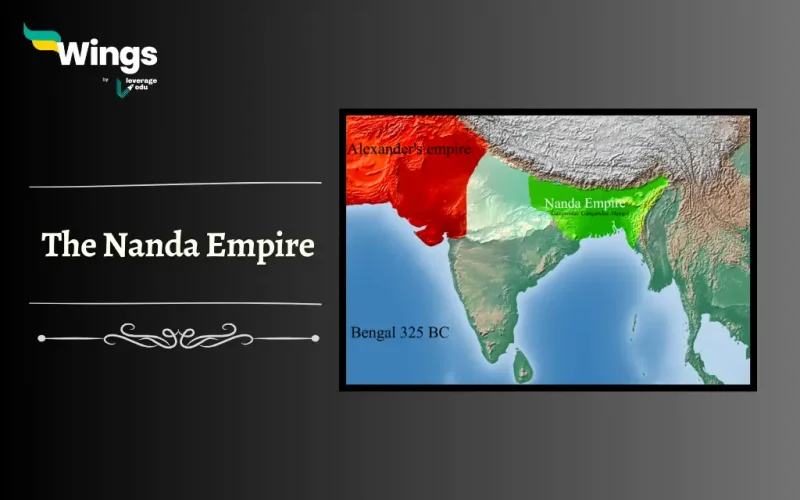The Nanda Empire was the fifth ruling dynasty of Magadha in ancient India. The formidable power had a significant role in shaping the political landscape of the Indian subcontinent during the fourth and possibly fifth centuries BCE. From its rise to power to its eventual decline, the Nanda Empire left an indelible mark on the socio-political landscape. Additionally, while the historical accounts vary in their details, the Nandas are generally believed to have ruled from around 345 to 322 BCE.
Table of Contents
- 1 The Rise of the Nanda Empire
- 2 Varied Narratives of the History of the Nanda Empire
- 3 Mahapadma Nanda and the Nanda Kings
- 4 Imperial Extent of the Nanda Empire
- 5 Empire’s Outstanding Military Strength
- 6 Administration During the Nanda Empire
- 7 Economic Prosperity and Trade
- 8 Cultural Contributions of the Nanda Empire
- 9 Why did the Nanda Empire Fall?
- 10 Legacy of the Nanda Empire
The Rise of the Nanda Empire
The Nanda Empire emerged in the 5th century BCE, marking the ascendancy of the Nanda dynasty. The founder of this dynasty was Mahapadma Nanda, a wise and ambitious ruler who successfully carved out a powerful realm in the fertile plains of northern India. However, Mahapadma Nanda’s reign laid the foundation for what would become one of the largest empires of ancient India.
Varied Narratives of the History of the Nanda Empire
One of the intriguing aspects of the Nanda empire is its low-status birth, as described in various ancient sources. According to Greek historian Diodorus and Roman historian Curtius, the founder of the Nanda dynasty was the son of a barber who treacherously assassinated the previous king and took control. Jain texts also corroborate this account, emphasizing the humble origins of the Nanda ruler. This contrasted with the traditional Kshatriya (warrior class) lineage of ruling dynasties.
The Puranas, on the other hand, assert that the Nandas were descendants of the Shaishunaga king Mahanandin. However, even these texts hint at their low birth, mentioning that Mahapadma, the Nanda founder, had a mother from the Shudra class, the lowest varna (social class).
The Buddhist tradition, as recorded in the Mahavamsa, describes the Nandas as “of unknown lineage,” suggesting their outsider status. This uncertainty surrounding their origins makes the Nandas a unique and intriguing dynasty.
Also Read: Haryanka Dynasty
Mahapadma Nanda and the Nanda Kings
Mahapadma Nanda’s power marked a momentous turning point in the political landscape of northern India. Moreover, Mahapadma Nanda’s strategic acumen and military prowess played an essential role in expanding the empire’s borders, thus creating a formidable state that included substantial territories.
The Nanda dynasty’s list of kings varies among different Buddhist, Jain, and Puranic sources that provide divergent accounts. While all traditions mention nine Nanda kings, the names they attribute to these rulers differ significantly. The lack of consensus adds to the historical mystery surrounding this dynasty.
However, according to Mahavamsa, the Sri Lankan Buddhist text, which was written in Pali, nine brothers were the Kings for a span of 22 years. They were:
- Ugra-sena
- Panduka
- Pandugati
- Bhuta-pala
- Rashtra-pala
- Govishanaka
- Dasha-siddhaka
- Kaivarta
- Dhana, the last ruler defeated by Chandragupta Maurya of the Mauryan Empire.
Must Read: Samudragupta Maurya, The Indian Napolean
Imperial Extent of the Nanda Empire
The Nanda capital was Pataliputra, located in present-day Patna, Bihar. The Nanda Empire extended over a vast territory, from present-day Punjab in the west to Odisha in the east. It also included regions like Avanti in Central India, likely making the Nandas the rulers of a significant portion of northern India. Their control over the Ganges valley, Kalinga on the eastern coast, and various other regions is supported by ancient accounts and inscriptions.
Empire’s Outstanding Military Strength
The backbone of the Nanda Empire and one of the most remarkable aspects of the Nanda dynasty was its military power. Ancient accounts, particularly those of Alexander the Great’s invasion of India, depict the Nandas as formidable opponents. The Greek writers mention the Nanda king Agrammes (likely a Nanda ruler) as having an army that included elephants, cavalry, infantry, and chariots. These accounts played a role in Alexander’s decision to halt his Indian campaign, as his exhausted soldiers resisted when faced with the prospect of war against this powerful kingdom.
Also Read: The Kalinga War
Administration During the Nanda Empire
The governance structure of the Nanda Empire was distinguished by a centralized administration. Mahapadma Nanda implemented policies that strengthened the authority of the central government, hence consolidating power in the hands of the ruling elite. Moreover, the empire was divided into provinces, each governed by appointed officials who reported directly to the central administration. Thus, this centralised governance allowed the Nanda rulers to maintain control over their vast territories.
Economic Prosperity and Trade
Economic prosperity was a hallmark of the Nanda Empire. The fertile plains of the Ganges River basin provided ample agricultural resources, hence guaranteeing a surplus that fueled the empire’s growth. Additionally, the Nanda rulers actively promoted trade and commerce by establishing trade routes that connected their empire with distant lands. This economic vibrancy not only enriched the imperial treasury but also promoted cultural exchanges with neighbouring regions.
Cultural Contributions of the Nanda Empire
The Nanda Empire was not only a political and military force but also a patron of the arts and learning. The rulers of the Nanda dynasty were known for their support of scholars and philosophers, promoting an intellectual environment that contributed to the development of literature, philosophy, and the sciences in ancient India. This cultural patronage left an enduring impact on the intellectual landscape of the subcontinent.
Also Read: Post-Mauryan Period
Why did the Nanda Empire Fall?
The later Nandas ruled during a period when they were deeply unpopular among their subjects. They faced criticism for their low social status, excessive taxation, and misconduct. The discontent among the populace eventually led to their overthrow. Chandragupta Maurya, with the guidance of Chanakya, successfully ended the Nanda dynasty’s rule and established the Maurya Empire.
Legacy of the Nanda Empire
Despite its relatively short-lived existence, the Nanda Empire left a lasting legacy on the Indian subcontinent. The administrative innovations introduced by the Nanda rulers influenced subsequent dynasties which were the Mauryas and the Guptas. Furthermore, the military strategies developed during the Nanda period continued to shape the military traditions of ancient India. Additionally, the economic policies of the Nanda Empire set the stage for a flourishing trade network that persisted for centuries.
The Nanda Empire, though usually overshadowed by the more known Maurya and Gupta empires played a vital role in shaping the course of ancient Indian history.
Mahapadma Nanda was a person from a non-ruling class who founded the Nanda dynasty.
In 321 BCE, a horrific battle between the Dhana Nanda of the Nanda Dynasty and the Maurya ruler Chandragupta Maurya destroyed the Nanda dynasty.
Before the Nanda empire, there was the Shaishunaga dynasty and India was ruled by diverse great kingdoms or Mahajanapadas.
Stay informed on Indian History and more with our General Knowledge section. Contact Leverage Edu for study abroad inquiries.
 One app for all your study abroad needs
One app for all your study abroad needs













